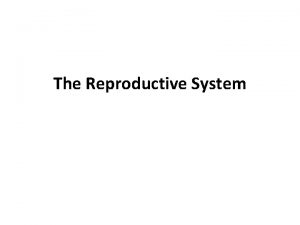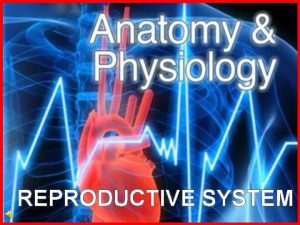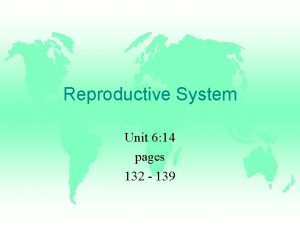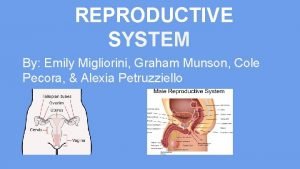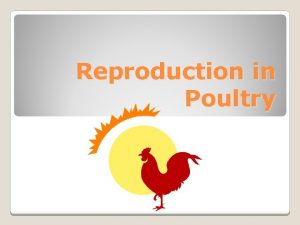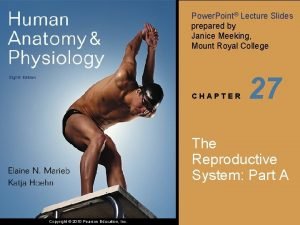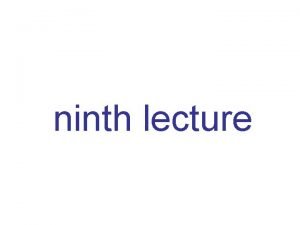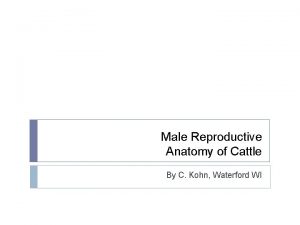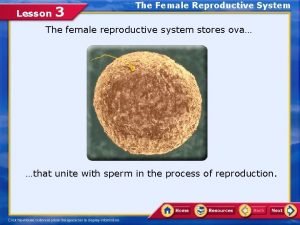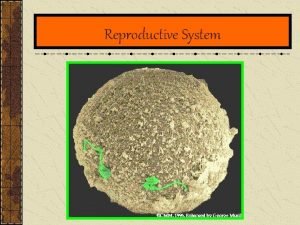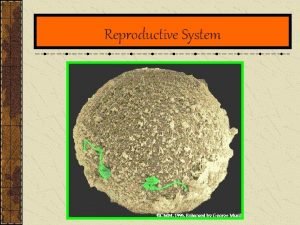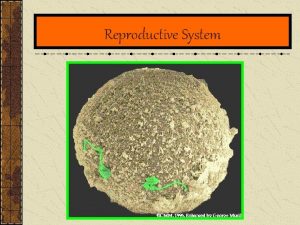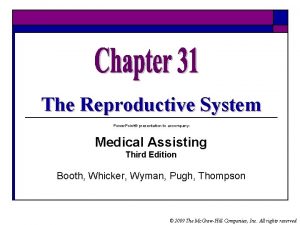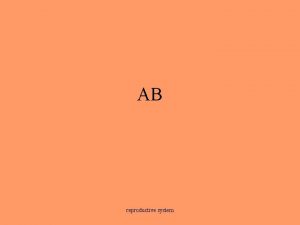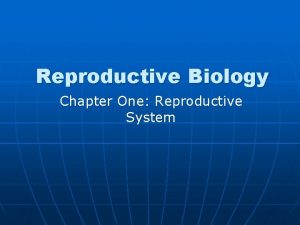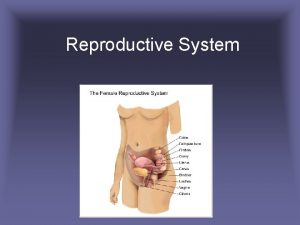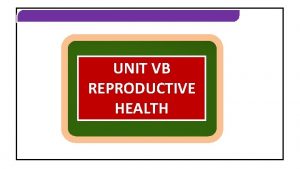The Reproductive System Power Point presentation to accompany






































- Slides: 38

The Reproductive System Power. Point® presentation to accompany: Medical Assisting Third Edition Booth, Whicker, Wyman, Pugh, Thompson © 2009 The Mc. Graw-Hill Companies, Inc. All rights reserved

31 -2 Learning Outcomes 31. 1 List the organs of the male reproductive system and give the locations, structures, and functions of each. 31. 2 Describe how sperm cells are formed. 31. 3 Describe the substances found in semen. 31. 4 Describes the process of erection and ejaculation. © 2009 The Mc. Graw-Hill Companies, Inc. All rights reserved

31 -3 Learning Outcomes (cont. ) 31. 5 List the actions of testosterone. 31. 6 Describe the causes, signs and symptoms, and treatment of various disorders of the male reproductive system. 31. 7 List the organs of the female reproductive system and give the locations, structures, and functions of each. 31. 8 Explain how ova develop. © 2009 The Mc. Graw-Hill Companies, Inc. All rights reserved

31 -4 Learning Outcomes (cont. ) 31. 9 List the actions of estrogen and progesterone. 31. 10 Explain how and when ovulation occurs. 31. 11 Describe what happens to an ovum after ovulation occurs. 31. 12 List the purpose and events of the menstrual cycle. 31. 13 Define menopause and explain what causes it. © 2009 The Mc. Graw-Hill Companies, Inc. All rights reserved

31 -5 Learning Outcomes (cont. ) 31. 14 Describe the causes, signs and symptoms, and treatments of various disorders of the female reproductive system. 31. 15 Explain how and where fertilization occurs. 31. 16 Describe the process of implantation. 31. 17 Explain the difference between an embryo and a fetus. © 2009 The Mc. Graw-Hill Companies, Inc. All rights reserved

31 -6 Learning Outcomes (cont. ) 31. 18 Describe the changes that occur in a woman during pregnancy. 31. 19 List several birth control methods and explain why they are effective. 31. 20 List the causes of and treatments for infertility. 31. 21 Describe the causes, signs and symptoms, and treatments of the most common sexually transmitted diseases. © 2009 The Mc. Graw-Hill Companies, Inc. All rights reserved

31 -7 Introduction o Male and female reproductive systems n n n Function together to produce offspring Female reproductive system nurtures developing offspring Produce important hormones © 2009 The Mc. Graw-Hill Companies, Inc. All rights reserved

31 -8 Male Reproductive System o Testes n o Scrotum – sac that holds the testes o Seminiferous tubules Primary organs o Develop in the abdominal pelvic cavity of fetus o Descend into scrotal sac shortly before or after birth n Produce the male sex cells (sperm) n Produce the male hormone testosterone o n On top of testes n Filled with spermatogenic cells that produce sperm cells Interstitial cells produce testosterone Male System © 2009 The Mc. Graw-Hill Companies, Inc. All rights reserved

31 -10 Male Reproductive System (cont. ) Spermatogenesis Spermatogonia (46 chromosomes) Mitosis – makes primary spermatocytes Undergo meiosis two secondary spermatocytes Divides – two spermatids = 4 spermatids Develop flagella to become mature sperm cells with 23 chromosomes © 2009 The Mc. Graw-Hill Companies, Inc. All rights reserved

31 -11 Male Reproductive System (cont. ) o Sperm cells n Head o o Nucleus with 23 chromosomes Acrosome – enzymefilled sac n n n Tail o Flagellum that propels sperm forward Helps sperm penetrate ovum Midpiece o Mitochrondria that generate cell’s energy © 2009 The Mc. Graw-Hill Companies, Inc. All rights reserved

31 -13 Male Reproductive System: Internal Accessory Organs o Epididymis n n n o Sits on top of each testis Receives spermatids from seminiferous tubules Spermatids become sperm cells Vas deferens n n Tube connected to epididymis Carries sperm cells to urethra o Seminal vesicle n Secrete o o n Fluid rich in sugar used to make energy Prostaglandins – stimulate muscular contractions in female to propel sperm forward Seminal fluid o o Released into vas deferens just before ejaculation 60% of semen volume Male System © 2009 The Mc. Graw-Hill Companies, Inc. All rights reserved

31 -14 Internal Accessory Organs Male Reproductive System: Internal Accessory Organs (cont. ) o Prostate gland n n Surrounds urethra Produces and secretes a milky, alkaline fluid into urethra just before ejaculation Fluid protects sperm in the acidic environment of the vagina 40% of semen o Bulbourethral (Cowper’s) glands n Produce a mucus-like fluid o o o Secreted just before ejaculation Lubricates end of penis Semen n Alkaline mixture o o n n Nutrients Prostoglandins 1. 5 to 5. 0 ml per ejaculate Sperm count of 40 to 250 million / ml Male System © 2009 The Mc. Graw-Hill Companies, Inc. All rights reserved

31 -15 Male Reproductive System: Internal Accessory Organs (cont. ) o Scrotum n Holds testes away from body n Temperature 1° below body temperature n o Penis n o n Lined with serous membrane that secrets fluid o Testes move freely Shaft Glans penis o n Cone-shaped structure on end of penis Prepuce o n Erectile tissues surround urethra Skin covering glans penis in uncircumcised males Functions o o Deliver sperm Urination Male System © 2009 The Mc. Graw-Hill Companies, Inc. All rights reserved

31 -16 Male Reproductive System: Erection, Orgasm, and Ejaculation o Erection n n o Orgasm n n o Parasympathetic nervous system stimulates erectile tissue Become engorged with blood Sperm cells propelled out of testes into urethra Secretions from accessory organs also released into urethra Ejaculation n Semen is forced out of urethra Sympathetic nerves then stimulate erectile tissue to release blood Penis returns to flaccid state © 2009 The Mc. Graw-Hill Companies, Inc. All rights reserved

31 -17 Male Reproductive System: Hormones o Hypothalamus n Gonadotropin-releasing hormone (Gn. RH) o Stimulates anterior pituitary to release n n n Follicle-stimulating hormone (FSH) – initiates spermatogenesis Luteinizing hormone (LH) – stimulates interstitial cells in the testes to produce testosterone Testosterone o o o Secondary sex characteristics Maturation of male reproductive organs Regulated by negative feedback © 2009 The Mc. Graw-Hill Companies, Inc. All rights reserved

31 -18 Apply Your Knowledge Matching: ANSWER: D Vasectomy ___ A. Spermatogenesis F Mixture of sperm and fluids ___ B. Testes A Sperm cell formation ___ C. Penis ___ G Secrete alkaline fluid / prostaglandins D. Vas deferens ___ B Produce testosterone E. Hypothalamus E Gn. RH ___ F. Semen C Erectile tissue ___ G. Seminal vesicle © 2009 The Mc. Graw-Hill Companies, Inc. All rights reserved

31 -19 Diseases and Disorders of the Male Reproductive System Disease/Disorder Description Benign prostatic hypertrophy (BPH) Nonmalignant enlargement of the prostate gland; common in older men Epididymitis Inflammation of an epididymis; usually starts as an urinary tract infection Impotence or Disorder in which erection cannot be erectile dysfunction achieved or maintained; about 50% of males (ED) between 40 and 70 have some degree of ED © 2009 The Mc. Graw-Hill Companies, Inc. All rights reserved

31 -20 Diseases and Disorders of the Male Reproductive System Disease/Disorder Description Prostate cancer Most common form of cancer in men over 40; risks of developing it increase with age Prostatitis Inflammation of the prostate gland; may be acute or chronic Testicular cancer Malignant growth in one or both testicles; more common in males 15– 30 years; more aggressive malignancy © 2009 The Mc. Graw-Hill Companies, Inc. All rights reserved

31 -21 Apply Your Knowledge Your patient has an elevated PSA. What is a PSA and what does it indicate? ANSWER: The PSA is a prostate-specific antigen in the blood. Elevations of the PSA may indicate prostate cancer. © 2009 The Mc. Graw-Hill Companies, Inc. All rights reserved

31 -22 Female Reproductive System: Ovaries and Ovum Formation o Ovaries (2) n Primary sex organs produce o o n n Located in the pelvic cavity Medulla o n Inner area; contains nerves, lymphatic vessels, and blood vessels Cortex o n Sex cells called ova Hormones estrogen and progesterone Outer area; contains ovarian follicles Covered by epithelial and dense connective tissues Female System © 2009 The Mc. Graw-Hill Companies, Inc. All rights reserved

31 -24 Female Reproductive System: Ovaries and Ovum Formation (cont. ) o Primordial follicles develop before birth and contain n A primary oocyte or immature ovum (born with maximum number) o Oogenesis is the process of ovum formation n At puberty, primary oocytes are stimulated to continue meiosis o n Follicular cells o Becomes 1 polar body (a nonfunctional cell) and A secondary oocyte n Secondary oocyte released during ovulation n If fertilized, the oocyte divides to form a mature, fertilized ovum © 2009 The Mc. Graw-Hill Companies, Inc. All rights reserved

31 -25 Female Reproductive System: o Internal Accessory Organs Fallopian tube – oviduct n Infundibulum and fimbriae o o n Fringed, expanded end of fallopian tube near ovary Function to “catch” an ovum Muscular tube o o Lined with mucous membrane and cilia Propels ovum toward uterus Internal Accessory Organs © 2009 The Mc. Graw-Hill Companies, Inc. All rights reserved

31 -26 Female Reproductive System: Internal Accessory Organs (cont. ) o Uterus n n n Hollow, muscular organ Receives embryo and sustains its development Divisions o o o Fundus – domed upper portion Body – main portion Cervix – narrow, lower section extending into vagina (cervical orifice) n Wall of uterus o Endometrium n n n o Innermost lining Vascular Tubular glands – mucus Myometrium n o Internal Accessory Organs Middle, thick, muscular layer Perimetrium n n Thin layer covering the myometrium Secretes serous fluid to coat and protect uterus © 2009 The Mc. Graw-Hill Companies, Inc. All rights reserved

31 -27 Female Reproductive System: Internal Accessory Organs (cont. ) o Vagina n n n Tubular, muscular organ Extends from uterus to outside body (vaginal introitus) Muscular folds – rugae – enable expansion o o n Receive erect penis Passage for delivery of offspring and uterine secretions Wall o o o Innermost mucosal layer Middle muscular layer Outer fibrous layer Internal Accessory Organs © 2009 The Mc. Graw-Hill Companies, Inc. All rights reserved

31 -28 Internal Female Organs Back © 2009 The Mc. Graw-Hill Companies, Inc. All rights reserved

31 -29 Female Reproductive System: External Accessory Organs o Mammary glands n n Secretion of milk Structures o Nipple n o o Oxytocin induces lactiferous ducts to deliver milk through openings Areola – pigmented area around nipple Alveolar glands – within mammary glands n Make milk when stimulated by prolactin © 2009 The Mc. Graw-Hill Companies, Inc. All rights reserved

31 -30 Female Reproductive System: External Genitalia o Collectively known as the vulva o Labia majora n n o Rounded folds of adipose tissue and skin Protect other external reproductive organs Labia minora n n Fold of skin between labia majora Very vascular Merge to form hood over clitoris Vestibule – space enclosed by labia minora o Bartholin’s glands secrete mucus during sexual arousal External Genitalia © 2009 The Mc. Graw-Hill Companies, Inc. All rights reserved

31 -31 Female Reproductive System: External Genitalia (cont. ) o Clitoris n n n o Anterior to urethral meatus Contains female erectile tissue Rich in sensory nerves Perineum n n Between vagina and anus Area for episiotomy, if needed, during birth process External Genitalia © 2009 The Mc. Graw-Hill Companies, Inc. All rights reserved

31 -32 Female Reproductive System: Erection, Lubrication, and Orgasm o Nervous stimulation n o Clitoris becomes erect Bartholin’s glands activates – lubrication Vagina elongates Orgasm n n Sufficient stimulation of clitoris Walls of uterus and fallopian tubes contract to propel sperm up tubes © 2009 The Mc. Graw-Hill Companies, Inc. All rights reserved

31 -33 Female Reproductive System: Hormones Hypothalamus secretes Gn. RH Anterior pituitary releases FSH & LH s te ula m Sti Ovaries to produce estrogen and progesterone Estrogen and progesterone v Responsible for development of secondary sex characteristics © 2009 The Mc. Graw-Hill Companies, Inc. All rights reserved

31 -34 Female Reproductive System: Reproductive Cycle o Menstrual cycle n Regular changes in uterine lining, resulting in monthly bleeding o Menarche – first menstrual period o Menopause – termination of cycle due to normal aging of ovaries © 2009 The Mc. Graw-Hill Companies, Inc. All rights reserved

31 -35 Female Reproductive System: Reproductive Cycle (cont. ) Anterior pituitary releases FSH Then releases LH Follicular cells become corpus luteum which secretes progesterone Ovarian follicle matures and secretes estrogen Triggers ovulation Uterine lining thickens Lining more vascular and glandular Without fertilization v Corpus luteum degenerates v Estrogen and progesterone levels fall v Uterine lining breaks down – menses starts v Cycle begins again with release of FSH © 2009 The Mc. Graw-Hill Companies, Inc. All rights reserved

31 -36 YIPPEE! Apply Your Knowledge True or False: ANSWER: ___ F The ovaries only produce estrogen. They also produce progesterone. F Ovulation is the process of ovum formation. ___ Oogenesis T The fallopian tube is also called the oviduct. ___ F The endometrium is the outer layer of the uterine wall. ___ T Alveolar glands produce milk. ___ inner layer lactiferous ducts F ___Oxytocin induces the alveolar glands to deliver milk through the nipples. F Menarche is the termination of the menstrual cycle. ___ the first menstrual cycle T Menopause occurs due to normal aging of the ovaries. ___ © 2009 The Mc. Graw-Hill Companies, Inc. All rights reserved

31 -37 Diseases and Disorders of the Female Reproductive System Disease/Disorder Description Breast cancer Second leading cause of cancer deaths in women; classified as stage 0 to 4 Cervical cancer Slow to develop; Pap smear detects abnormal cervical cells Cervicitis Inflammation of the cervix usually due to an infection Dysmenorrhea Condition with severe menstrual cramps limiting normal activities © 2009 The Mc. Graw-Hill Companies, Inc. All rights reserved

31 -38 Diseases and Disorders of the Female Reproductive System (cont. ) Disease/Disorder Description Endometriosis Tissues of uterine lining growing outside of the uterus Fibrocystic breast disease Abnormal cystic tissue in the breast; size varies related to menstrual cycle; common in 60% of women between 30 and 50 Fibroids Benign tumors in the uterine wall; affect 25% of women in their 30 s and 40 s Considered more deadly than other types; detection difficult and often spreads before detection Ovarian cancer © 2009 The Mc. Graw-Hill Companies, Inc. All rights reserved

31 -39 Diseases and Disorders of the Female Reproductive System (cont. ) Disease/Disorder Description Premenstrual syndrome (PMS) Collection of symptoms occurring just before a menstrual period Vaginitis / vulvovaginitis Inflammation of the vagina / inflammation of vagina and vulva; both associated with abnormal vaginal discharge Uterine Most common in post-menopausal women; (endometrial) cancer causes about 6% of cancer deaths in women © 2009 The Mc. Graw-Hill Companies, Inc. All rights reserved

31 -40 Apply Your Knowledge Matching: ANSWER: E Inflammation of the cervix ___ A. Dysmenorrhea G Cancer common in post-menopausal women ___ B. Cervical cancer B Develops slowly; detected by Pap smear ___ C. Fibroids ___ F Uterine tissue grows outside uterus D. Breast cancer D Second leading cause of cancer death in women E. Cervicitis ___ A Severe menstrual cramps ___ F. Endometriosis C Benign tumors in the uterine wall ___ G. Uterine cancer © 2009 The Mc. Graw-Hill Companies, Inc. All rights reserved

31 -41 Pregnancy: Fertilization o Pregnancy – condition of having a developing offspring in the uterus o Fertilization – process in which a sperm cell unites with an ovum; results in pregnancy n Only one sperm cell penetrates the follicular cells and the zona pellucida that surround the ovum’s cell membrane n After fertilization, ovum releases enzymes that cause the zona pellucida to become impenetrable to other sperm n Zygote forms from union of ovum and sperm o Contains 46 chromosomes © 2009 The Mc. Graw-Hill Companies, Inc. All rights reserved
 Hebrews 6:9-12 sermon
Hebrews 6:9-12 sermon Accompany chapter 1
Accompany chapter 1 Dorsal metacarpal veins
Dorsal metacarpal veins Accompany
Accompany Topics for powerpoint presentation for class 4
Topics for powerpoint presentation for class 4 Power point presentation design west vancouver
Power point presentation design west vancouver Ducts in female reproductive system
Ducts in female reproductive system Endocrine system and reproductive system
Endocrine system and reproductive system Power triangle formula
Power triangle formula Power bi power point
Power bi power point Point point power
Point point power Power angle curve in power system stability
Power angle curve in power system stability Function of the vagina
Function of the vagina Examination of reproductive system
Examination of reproductive system Seminal tubules
Seminal tubules Fetus reproductive system
Fetus reproductive system Chapter 16 the reproductive system
Chapter 16 the reproductive system Anatomy of the reproductive system exercise 42
Anatomy of the reproductive system exercise 42 Femaleanatomy
Femaleanatomy Lutalphase
Lutalphase Female reproductive system pregnancy
Female reproductive system pregnancy Unit 6:14 reproductive system
Unit 6:14 reproductive system Female external genitalia labelled diagram
Female external genitalia labelled diagram Reproductive system jeopardy
Reproductive system jeopardy What is reproductive system
What is reproductive system Pearson education
Pearson education Reproductive system definition
Reproductive system definition Luteinizing hormone in male reproductive system
Luteinizing hormone in male reproductive system Poultry reproductive system
Poultry reproductive system Male reproductive system in plants
Male reproductive system in plants Art-labeling activity: the male reproductive system, part 1
Art-labeling activity: the male reproductive system, part 1 Do chickens have vaginas
Do chickens have vaginas Male reproductive system information
Male reproductive system information Reproductive organ
Reproductive organ Functions of testes
Functions of testes Prostate anatomy
Prostate anatomy Unit 5 lesson 3 the female reproductive system
Unit 5 lesson 3 the female reproductive system Asexual reproduction
Asexual reproduction Disease traductor
Disease traductor















